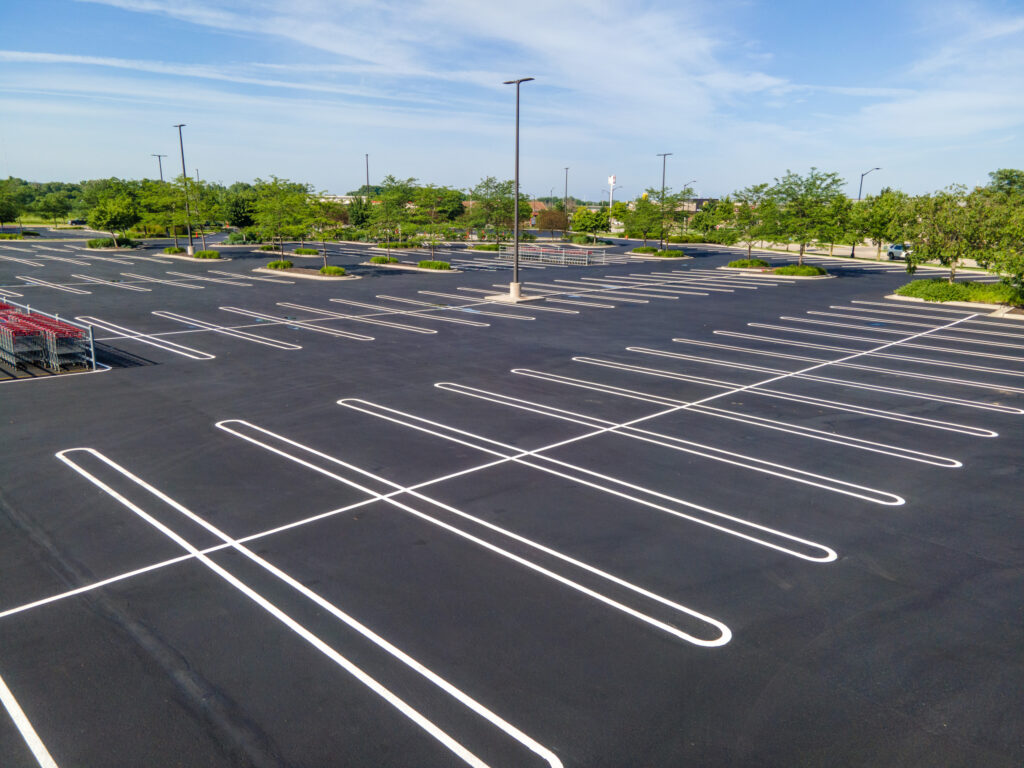American Pavement Solutions is your one-stop shop for all commercial and industrial pavement needs. We’ve been exceeding expectations nationwide for over 45 years and are proud to serve businesses of all sizes right here in Green Bay, WI.
Schools:
- Prioritize safety: Our durable pavements create a safe environment for students, patients, and staff.
- Minimize disruptions: We work efficiently to minimize downtime and ensure your facility remains operational.

We understand that every industry has unique pavement demands. That’s why we offer comprehensive services tailored to each sector, ensuring long-lasting results and minimal disruption to your operations.
ADA Compliance for School Parking Lots
Ensuring that school parking lots are ADA-compliant is essential to provide equal access for students, parents, staff, and visitors with disabilities. Compliance not only demonstrates a school’s commitment to accessibility but also fulfills federal legal obligations under the Americans with Disabilities Act (ADA). Below is a comprehensive guide for schools to align their parking facilities with ADA standards and foster inclusivity.
1. What is ADA-Compliant Parking?
ADA-compliant parking spaces are designed to ensure safe and accessible routes for individuals with disabilities. This involves providing both standard accessible and van-accessible spaces and barrier-free paths from parking areas to school entrances. These spaces must meet specific size, marking, and signage requirements to accommodate individuals using mobility aids, such as wheelchairs and lifts.
2. How Many Accessible Parking Spaces Are Required?
The ADA sets the minimum number of accessible parking spaces based on the total number of parking spaces in the lot:
- 1 accessible space per 25 spaces for parking lots with up to 25 total spaces.
- At least 1 van-accessible space for every 6 accessible spaces.
- For larger lots, 2% of the total spaces must be accessible.
- Schools with multiple parking lots must provide accessible spaces near all primary and accessible building entrances.
This ensures that all users, including those visiting administrative offices, sports facilities, or drop-off areas, can access appropriate parking.
3. What Are the Requirements for Accessible Spaces?
Dimensions:
- Standard Accessible Spaces: 8 feet wide with a 5-foot access aisle.
- Van-Accessible Spaces: 11 feet wide with a 5-foot access aisle (or 8 feet wide with an 8-foot aisle for shared usage).
- Vertical Clearance: Van-accessible spaces must have a clearance of 98 inches to accommodate vehicles with lifts.
Marking and Signage:
- Marked with the international symbol of accessibility.
- Signs for van-accessible spaces must indicate that they are reserved for vans.
- Access aisles must be striped to prevent parking in those spaces.
4. Placement and Pathways
Accessible spaces must be located close to accessible entrances, ensuring that users have barrier-free paths from the parking lot to the school building. These routes should:
- Avoid steps, steep slopes, or curbs.
- Be at least 3 feet wide with a stable, slip-resistant surface.
- Provide curb ramps where necessary to facilitate smooth entry into walkways and entrances.
If a school has multiple buildings or entrances used by different groups, accessible spaces should be distributed to cover each key area effectively
5. ADA Compliance During Lot Restriping or Renovation
Restriping or modifying school parking lots allows one to update parking layouts to meet current ADA standards. The ADA considers such upgrades “readily achievable” since they are low-cost improvements promoting accessibility. Schools should:
- Inspect signage, striping, and spaces regularly to be visible.
- Ensure accessible routes remain clear of obstacles, especially during construction or snow season.
- Coordinate with maintenance teams to monitor wear and tear on painted lines and signs.
6. Drop-off Zones and Accessible Bus Parking
Schools often have drop-off or loading zones, which must also meet ADA requirements:
- Provide at least one accessible loading zone with an adjacent curb ramp.
- Bus parking areas should accommodate students with mobility aids by offering accessible loading areas connecting to building entrances.
7. Maintaining Compliance and Avoiding Penalties
Failure to comply with ADA requirements can result in fines, lawsuits, and negative community impact. Schools must conduct regular inspections to identify:
- Faded signage or striping.
- Blocked access routes due to parked vehicles, snow, or debris.
- Construction disruptions that hinder access.
Staff should be trained to monitor parking lot accessibility and assist users during events or emergencies.
8. Conclusion
ADA-compliant parking is essential for schools to ensure everyone—students, staff, and visitors—can access the campus comfortably and safely. Schools promote inclusivity and avoid potential legal challenges by following ADA standards for parking lot design, placement, and maintenance.
For more detailed requirements and further guidance, visit the ADA’s official page on parking compliance


